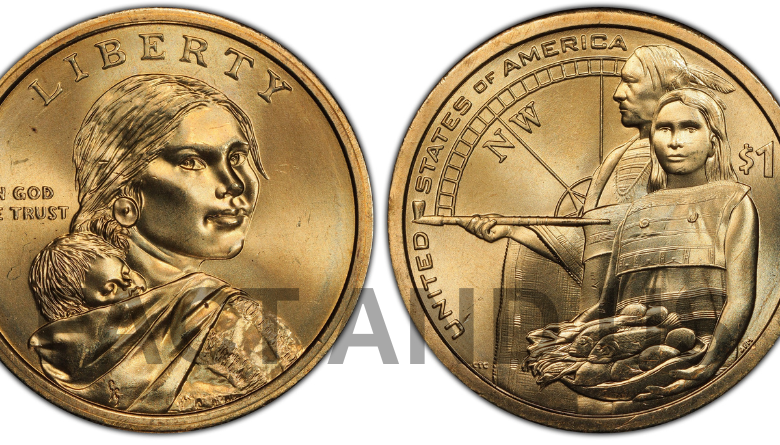Sacagawea, also spelled Sakakawea or Sacajawea; May c. (1788 – December 20, 1812, or April 9, 1884) was a Lemhi Shoshone woman who, in her teens, helped the Lewis and Clark Expedition achieve its chartered mission objectives by exploring the Louisiana Territory. Sacagawea traveled thousands of miles with the expedition from North Dakota to the Pacific Ocean, establishing cultural contact with Native American peoples.In the early 20th century the National American Woman Suffrage Association adopted Sacagawea as a symbol of women’s value and independence, erecting several statues and plaques in her memory and doing much else to commemorate her achievements.

Sacagawea was a Shoshone woman who accompanied the Lewis and Clark expedition in 1804–06. Also called the Corps of Discovery, the expedition traveled from the northern plains through the Rocky Mountains to the Pacific Ocean and back. His skills as a translator were invaluable, as was his intimate knowledge of some difficult terrain. Perhaps most importantly, he had a calming presence with both the expedition team and the Native Americans he encountered, who might otherwise have been hostile toward strangers. Remarkably, Sacagawea did all this while caring for the son she had given birth to just two months before her departure.
Contents
Early life
Reliable historical information about Sacagawea is very limited. He was born in about 1788 into the Agadika (‘Salmon Eater’, aka Lemhi Shoshone) tribe near present-day Salmon, Idaho. It is near the Continental Divide on the present-day Idaho-Montana border.
In 1800, when she was about 12 years old, Sacagawea and several other children were taken captive by a group of Hidatsa in a raid that resulted in the deaths of several Shoshone: four men, four women, and several boys. He was held captive in a Hidatsa village near present-day Washburn, North Dakota.
At about the age of 13, she was sold into marriage without consent to a trapper from Quebec named Toussaint Charbonneau. He also purchased another young Shoshone girl, known as Otter Woman. Varying reports about Charbonneau state that he purchased both girls from the Hidatsa, or that he won Sacagawea while gambling.
Louisiana purchase
Meanwhile, President Thomas Jefferson had purchased Louisiana from France in 1803 – an almost entirely unknown territory of 828,000 square miles. Within this vast wilderness they hoped to find what was rumored to be the Northwest Passage, the legendary waterway that had long been a trade route connecting the Atlantic and Pacific oceans.
But Jefferson wanted more from the explorers who would discover the route: He tasked them with surveying the landscape, learning about various Native American tribes, collecting natural specimens, and making maps. He appointed his secretary, Meriwether Lewis, to lead the search party. Lewis, 29, chose his friend and former military superior, 33-year-old William Clark, as his co-captain.

Lewis and Clark meet Sacagawea
After more than a year of planning and preliminary travel, Lewis and Clark and their men arrived at the Hidatsa-Mandan settlement on November 2, 1804 – about 60 miles northwest of present-day Bismarck, North Dakota – at which time Sacagawea was approximately She was six months pregnant.
He recognized the potential value of Sacagawea and Charbonneau’s combined language skills. Most members of the corps spoke only English, but one, François Labich, also spoke French. Charbonneau spoke French and Hidatsa; The Sacagawea spoke Hidatsa and Shoshone (two very different languages).
Through this translation chain, communication with the Shoshone would be possible. Lewis and Clark also recognized that the Shoshone had horses that they would need to purchase.
Without horses, they could not carry their supplies over the Bitterroot Mountains (a rugged part of the Rockies) and head toward the Pacific Ocean. And they could not purchase horses at first, because they would have to travel by water until they reached the edge of the Rockies.
On 11 February 1805, Sacagawea gave birth to their son Jean-Baptiste Charbonneau (known as Baptiste). On April 7, Sacagawea, Bacha, and Charbonneau headed west with 31 other corps members.
Sacagawea saved the day
Within a month, a near-tragedy brought Sacagawea special respect. The boat she was sailing in almost capsized when a storm arose and Charbonneau, the sailor, panicked.
Sacagawea had the foresight to collect important papers, books, navigational equipment, medicines, and other items that might otherwise have gone missing – while at the same time ensuring her child’s safety. In gratitude, Lewis and Clark named a branch of the Missouri River after Sacagawea several days later.
Clark, in particular, had developed a close relationship with the Sacagawea, as he and Baptiste would often walk along it along the shore, examining the river for obstacles that could damage the boats.
Years after Sacagawea
Three years later, in the autumn of 1809, Sacagawea, Charbonneau, and Baptiste traveled to St. Louis, where Charbonneau made the kindly Clark a proposal: Clark would provide the Charbonneau family with land for farming, provided that the parents would allow Clark to receive Baptiste’s Agree to provide education.
However, the ranching was not successful, and in April 1811 Sacagawea and Charbonneau left Baptiste in St. Louis with Clark (who was now their godfather) to join a fur-trading expedition.
How did Sacagawea die?
In August 1812, after giving birth to daughter Lisette (or Lizette), Sacagawea’s health deteriorated. By December, she became very ill with “decompression fever” (possibly typhoid fever).
He died at the age of 25 on December 22, 1812, at Fort Manuel, located on a cliff 70 miles south of present-day Bismarck. He may have been buried at the Wind River Reservation, which was occupied by the Lemhi Shoshone tribe, but some scholars dispute this.
Within a year, Clark became the legal guardian of both Lysette and Baptiste While little is known about Lisette’s life, Baptiste traveled to Europe and held a variety of jobs in the American West before her death in 1866. Charbonneau died in 1843.In August 1812, after giving birth to daughter Lisette (or Lizette), Sacagawea’s health deteriorated. By December, she became very ill with “decompression fever” (possibly typhoid fever).
Within a year, Clark became the legal guardian of both Lysette and Baptiste. While little is known about Lisette’s life, Baptiste traveled to Europe and held a variety of jobs in the American West before her death in 1866. Charbonneau died in 1843.
Stay connected with Fact and US for more such news.
